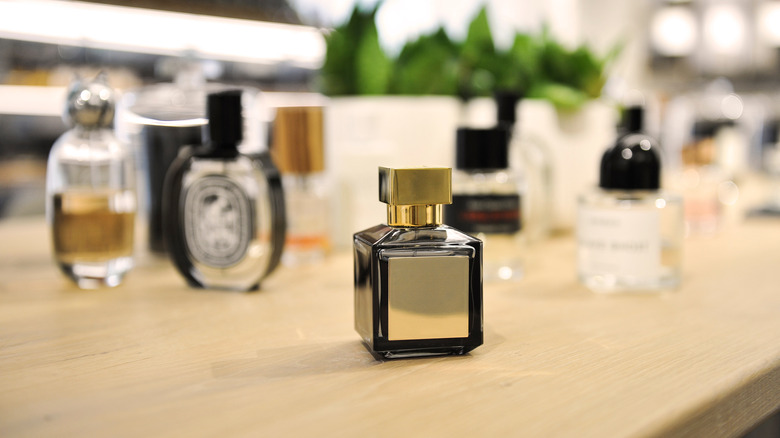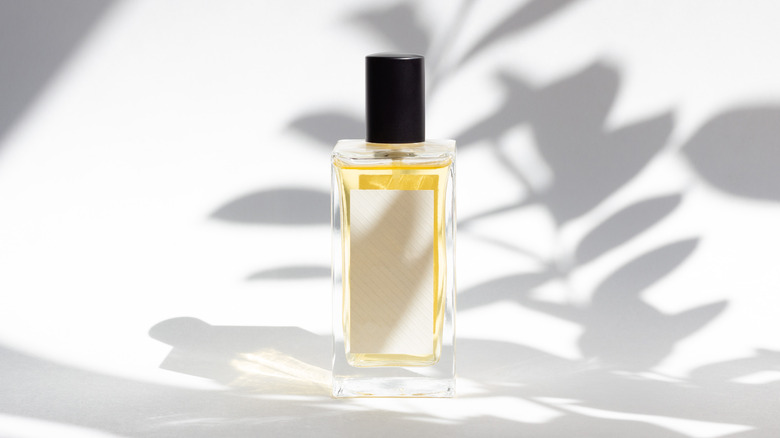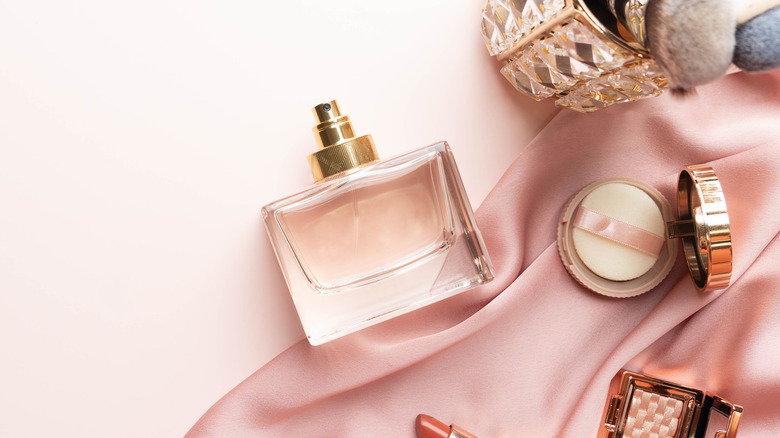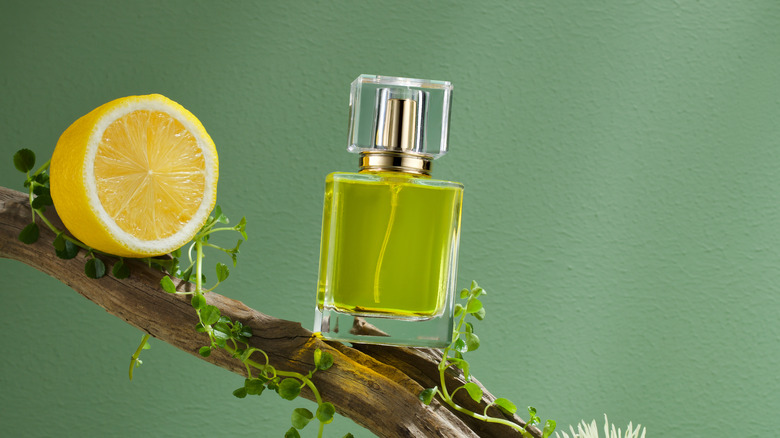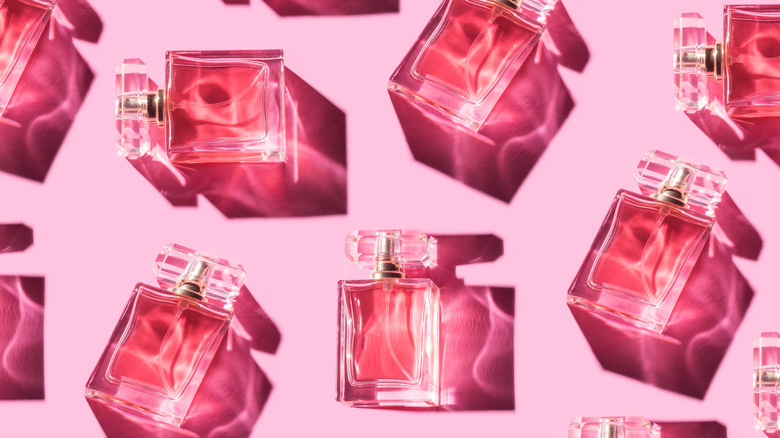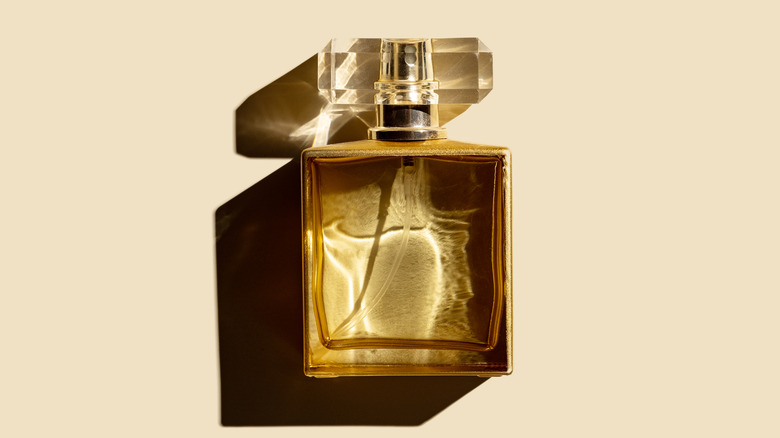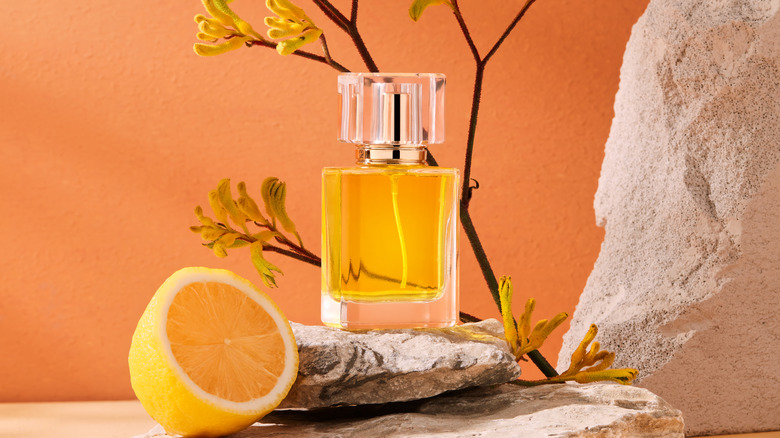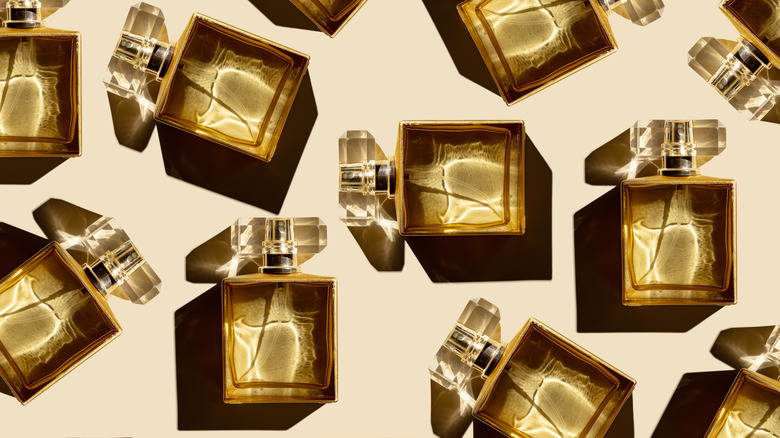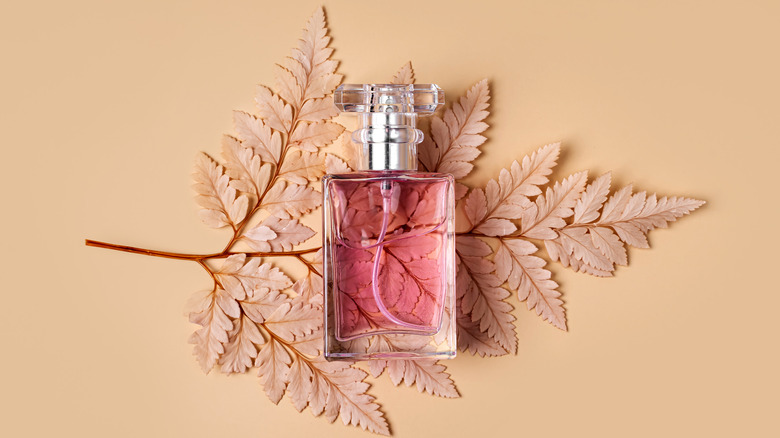Think Twice About Buying Fragrances With These Ingredients
Who doesn't love a good perfume? Spritzing on your favorite fragrance after getting glam for a night out might be your secret weapon – and putting some on before an important board meeting can be the key to your confidence and success. It's no secret that scent is deeply powerful when discussing human cognition and memory. The Harvard Gazette explains that the brain's olfactory bulb processes smell and sends the information to the limbic system, including the amygdala and hippocampus. Since both of them are connected to our emotions and even our memories, scent can trigger powerful responses in us. Think of that perfume your grandma used to smell like when you stayed over at her house as a child. You can almost taste the strawberry wrapped candies and feel the fuzzy pajamas you had on. Similarly, you might have a favorite fresh, energizing perfume you've spritzed on every morning for years, which may have become your go-to for feeling awake or for seizing the day. We connect scent to emotions, the past, and immediate, instinctual responses.
While all that's well and good, the perfume you use might be harming you. Yes, your favorite scent might be full of harmful chemicals you don't want near your body: ingredients that are hormone disruptors or even carcinogens. Since your skin's pores soak in perfume, it is crucial to avoid certain elements – and we've found the worst ones you need to avoid.
Phthalates
First up, we have the most common harmful ingredient in perfumes: the sneaky yet potentially dangerous phthalates. You might have spritzed phthalates onto your skin every day for the past 15 years without realizing it, especially without readily-available information on its adverse effects. So what are they? As per Alitura, phthalates are ubiquitous in popular fragrances and are known endocrine disruptors that can send your hormones on a rollercoaster ride without you even realizing what's going on. Have you been breaking out lately? Or have you lost or put on weight recently for apparently no reason? Sweating at night, irritability, and irregular periods can all be signs of a hormonal imbalance, and before you check your diet, check your perfume's ingredient list. If phthalates are on it, you might have your culprit right on your bathroom counter.
Phthalates are also obesogens, making you put on weight by lowering your metabolism rate. Phthalates can also cause damage to the liver, kidneys, lungs, and reproductive system (via The Discovery Doc). Similarly, the chemical can lower testosterone levels in both men and women, impacting the hormonal system as a whole. You should also think twice about spritzing on phthalates during pregnancy since studies have linked them to negative impacts on a fetus's neurological development.
Musk ketone
Next up is musk ketone, otherwise known as one of the most harmful ingredients found in makeup, skincare, and perfumes. You would be surprised at the sheer amount of fragrances that include this component, even from super-luxe brands that promise quality (not to mention safety). According to Alitura, musk ketone can irritate the skin, so if you've felt a rash developing on places you usually spray perfume on, check the ingredient list. If you have sensitive skin, dermatitis, rosacea, or acne you should not use perfumes with musk ketone at any cost, because it might only exacerbate the problem.
Moreover, musk ketone is a hormonal disruptor, sending your testosterone, estrogen, cortisol, insulin, and progesterone into overdrive, going up and down and making you feel just off. If lately you feel extra tired, hungrier, irritable, and you've even seen a difference in your sex drive, you should check your perfume's ingredients for musk ketone. So why do companies include it in so many fragrances in the first place? As per The Discovery Doc, this is what gives woodsy, complex perfumes their musky odor. But synthetic musks only confuse your endocrine system and are linked to ovarian failure, infertility, and even damaged brain cells. Healthline also lists musk ketone as a toxic ingredient you should steer clear of, especially if pregnant.
Styrene
Another ingredient to steer clear of is styrene. Found in tons of perfumes by big-name brands, styrene is not a luxurious component in the slightest but is still used in fragrances that cost upwards of $200. According to The Discovery Doc, styrene is a flammable liquid much like gasoline that is usually a component in industrial products like fiberglass, rubber, polystyrene plastics, and latex. As per Truth in Aging, it's used by the beauty industry to increase the staying-power of fragrances, makeup products, lotions, and even sunscreen, but its dangerous effects far outweigh the positives.
Consumers wonder why styrene is still found in so many products, especially after a 2011 study by the National Toxicology Program and the National Academy of Science that showed that it is an "anticipated human carcinogen." This means that constant use of styrene on the body can eventually cause cancer. It can also wreak havoc on your brain's functions, nervous system, kidneys, and even your everyday ability to concentrate at work or school. If you've been feeling depressed, down in the dumps, fatigued, extra tired, or have had migraines, toss your styrene-imbued perfume stat.
BHT
While there are tons of harmful ingredients in perfumes nowadays, few components beat the harmful effects of BHT on the body. Otherwise known as butylated hydroxytoluene, it is related to developmental and reproductive toxicity when pregnant, to different allergies, including skin irritations, and can even lead to cancer. The Environmental Working Group found a whopping 99 common fragrances for women and 76 colognes for men that include this ingredient. A 2012 European Food Safety Authority found that BHT may cause liver cancer, while other studies have shown it can also lead to different tumors. While these effects are not set in stone for everyone and may vary, why take the risk?
As per Sole Toscana, BHT is widespread in fragrance products, and is used as a preservative to make perfumes last longer. However, that comes with a price since BHT acts like estrogen when spritzed on the body. This confuses the hormonal system for men and women and can cause acne, night sweats, painful periods, and more. As it is related to cancer, it is often dangerous and can accumulate in the body. Plus, you don't have to watch out for BHT in your just favorite fragrance. Scarily enough, it can also be found in food like chips and butter.
Benzaldehyde
You might have never heard of benzaldehyde before, and who can blame you? But unfortunately, this is a chemical found in everything from fragrances to laundry products to deodorant. It's also found in shampoo, dishwashing soap, body soap, hairspray, and much more, as per Eco Beauty Editor. While a bit of exposure won't necessarily cause much damage, most of us are exposed to this chemical daily, causing a build-up in the body that is anything but healthy.
If you find that your go-to perfume has benzaldehyde, you should think about replacing it with a natural alternative. Why? As per The Discovery Doc, a 1991 EPA study found that benzaldehyde was found in countless fragrances, and when inhaled, could cause irrevocable damage to the human body. The study found benzaldehyde may cause central nervous system disorders, slurred speech, drowsiness, skin irritation, nausea, kidney damage, and even respiratory failure, among other side effects. This is reason enough alone to ditch your chemical-imbued perfume. According to Alitura, benzaldehyde is also a narcotic and can irritate your entire organism while also leading to abdominal pain.
Ethylene glycol
One of the most common "bad guys" of the chemical ingredient world is probably found in almost every perfume you have: ethylene glycol. While this is a common ingredient for fragrances and beauty products, it has no place anywhere near your body, especially when talking about repeated, long-term exposure. Healthline named it one of the most dangerous irritants found in perfumes, which everyone, especially pregnant women, should avoid. This chemical may cause hormonal imbalances that can damage your mental health, trigger asthma, and even harm your reproductive system. These are genuine concerns and reason enough not to buy that ah-mazing smelling perfume with ethylene glycol. It's not worth it!
As per Medline Plus, ethylene glycol is a poisonous ingredient found in products like antifreeze, car wash soaps, paint, vehicle brake fluids, and industrial solvents – things that need hefty, harsh chemicals to get the job done. Clearly, something in de-icing liquids should not be found on your skin, but ethylene glycol is just as commonly found in perfumes and makeup. According to the Centers for Disease Control and Prevention (CDC), large quantities of ethylene glycol in the body are hazardous and can become toxic. The CDC says any harm in absorbing it through the skin is "unlikely," but you probably shouldn't take the risk.
Camphor
Ah, camphor. An ingredient that you might associate with all-natural camphor laurel, found in evergreen trees. Sounds great, right? Unfortunately, the kind of camphor found in modern-day fragrances and makeup is not natural in the slightest and is almost always synthetic and made from turpentine oil, as per WebMD. AKA a paint solvent that has no place anywhere near your delicate organism, hormone system, or skin. Used often in synthetic cough treatments like Vicks VapoRub, this is a definite no in our books for any product applied to the body – perfumes included.
According to Alitura, camphor is one of the most dangerous chemicals found in fragrances and can cause a range of symptoms like nausea, twitching, dizziness, and even convulsions. If you've experienced any of these for apparently no reason, check your perfume's ingredient list for camphor. In 1991, this ingredient was studied by the United States Environmental Protection Agency (EPA) and was found to be equally toxic to the human body if breathed in (via The Discovery Doc). And the chemical isn't just in your perfume. Also, watch out for camphor in your nail polish, detergent, shaving cream, and home air fresheners that are constantly inhaled (via Eco Beauty Editor).
Methylene chloride
Methylene chloride is often found in fragrances and is one of the most common beauty product ingredients. This component acts as a solvent for other ingredients but does more harm than good. As per Return2Health, this is a sneaky component you might not know you are spritzing on every day and has dangerous effects when used for prolonged periods. It can irritate your skin and cause chemical burns if you have sensitive skin or conditions like psoriasis or dermatitis. It is also toxic to pregnant women and might make its way into the placenta, while also being a carcinogen linked to pancreatic, liver, and lung cancer. Methylene chloride is not an ingredient you want anywhere near your body.
According to The Discovery Doc, methylene chloride is also found in pesticides and septic tank cleaners, making it 100% not something we want on our skin. It is also found in paint strippers, polyurethane foam, and degreasers. Incredibly enough, the FDA banned this ingredient in 1988 from perfumes because it was too toxic for human use, but it can still be found secretly under the general label "fragrance." For this reason, avoiding perfumes that list "fragrance" as an ingredient is crucial, too.
Benzyl acetate
Benzyl acetate is a seemingly harmless ingredient that you might have never thought about, but it might be wreaking all kinds of havoc on your body from the inside out. According to Eco Beauty Editor, it is found in a long list of perfumes you've probably used, as well as men's colognes, air fresheners, hairsprays, deodorants, fabric softeners, and shampoos. It's safe to say this chemical is everywhere. While avoiding this ingredient may seem like an impossible task, it is crucial to try.
Benzyl acetate is a super-sleuth ingredient that seems innocent because of its sweet, jasmine-like scent (via The Discovery Doc). However, it is anything but beneficial, secretly harming you instead. Why? Although it gives off a fruity aroma, making it perfect for perfume and makeup, it is the main solvent component in industrial products like lacquer, polish, ink, nitrate, oil, resin, and plastic. While that's not something we want to spritz on our wrists every day, it is a carcinogen as well, linked to pancreatic cancer. Also, as per Alitura, it can irritate your eyes and lungs, so if you've experienced trouble breathing or have had dry, red eyes as of late, check your perfume's ingredient list for benzyl acetate.
Acetaldehyde
Another ingredient that is common in perfumes but might be even more toxic than most of the other components we've included is acetaldehyde. As per Healthline, this is one of the most toxic ingredients found in fragrances, especially if you're pregnant. It can throw off your respiratory system, sending your lungs into a tailspin and causing irritation, while also sending your hormones up and down. While we don't want anything to damage our reproductive system, the effects go beyond that. Incredibly enough, acetaldehyde continues to be common in many fragrances and is used to make scents more "bubbly," fresh, and light (via Scentbird). Perfumers love it because it makes fragrances slightly citrusy, softer, and green – almost like you're just leaving the most perfect spa day. It also makes perfumes longer-lasting and more powerful, so it's no wonder why companies love it as an ingredient.
But as per The Perfume Society, acetaldehyde is a synthetic chemical formed by the oxidation of alcohols, and is dangerous to humans when applied daily. The chemical can lead to lung damage and negatively affect your heart and blood vessels. Some studies have shown that it can even lead to cancer and worsen your memory.
Ethyl acetate
Yet another common fragrance ingredient you don't want anywhere near your body is the chemical ethyl acetate. But the problem is, it's found in many household products. As per Eco Beauty Editor, it is a common component in bathroom products like aftershave, shampoo, cologne, and perfume. Even more, it is a toxic ingredient in most nail polishes, nail polish remover, dishwashing soap, and detergents. In short, unless you buy all-natural alternatives (or make your own!), ethyl acetate is unfortunately probably a part of your life without you even realizing it. Even worse, this ingredient is commonly hidden under the word "fragrance" in ingredient lists, so you don't always know if you're spritzing it on or not. This is why avoiding any "fragrance" on a label is crucial, too.
So what are ethyl acetate's harmful effects? Like many of the other ingredients we've listed, they can be truly damaging to your organism. As explained by Alitura, ethyl acetate is a known eye irritant and can also cause serious respiratory issues and lung damage down the line, particularly with prolonged use. Moreover, as per The Discovery Doc, this super-common ingredient was also part of the EPA's hallmark 1991 study and found to be equally harmful to the nervous system, organs, GI tract, skin, and eyes. According to VelocityEHS, this chemical is often used in fragrances because of its sweet smell but is highly flammable and toxic when inhaled.
Limonene
Just like the aforementioned ethyl acetate and benzyl acetate, limonene is a sweet-smelling chemical that adds a fresh lemon scent to perfumes, as per Fragrance Conservatory. If you own a citrus perfume, check the ingredient list. Chances are, limonene is on there. Perfumers love it because it is entirely colorless and quite subtle while cutting through sweet scents with just a bit of acidity. It makes fragrances smell incredible, but considering its adverse effects on the body, it doesn't seem worth it in the slightest.
So what's the problem with limonene? Well, there's a lot. To start, limonene was found to cause irrevocable damage to organs ranging from the liver to the heart to the lungs. It could also cause headaches, fatigue, skin irritation, and nerve damage (via The Discovery Doc). Plus, limonene is also a known carcinogenic, possibly causing cancer down the line if used for a prolonged period (via Alitura). Unfortunately, it is found in almost every household product with a lemony scent. Apart from perfumes, it is also a component in air fresheners, bleach, paint, varnish, fabric softener, deodorant, bar soap, shaving cream, and disinfectant (via Eco Beauty Editor). Avoiding it isn't easy but should be prioritized to prevent long-term health issues later.
Linalool
Linalool is a known toxic ingredient but continues to be found in countless familiar fragrances. Just like limonene, perfumers love linalool for the amazing scent it imparts. As per The Perfume Society, it is a spicy floral compound that is often found in flower-based, sweet fragrances, or muskier perfumes that are perfect for the evening.
The good news about linalool is that perfume companies are forced to write it on the ingredient list, and it can't be disguised under "fragrance." This is because several people are allergic to it, which only further points to its possible toxicity. Linalool is found everywhere, ranging from floral perfumes to soap to detergent. But it is most dangerous when it comes to fragrances and air fresheners because it is inhaled (via Eco Beauty Editor). As per Alitura, it can severely damage the respiratory system, cause trouble breathing, and be linked to nervous system disorders, depression, and anxiety.
Oxybenzone
Healthline explains oxybenzone can lead to perfume poisoning and should be avoided by anyone looking to reduce their toxicity levels and exposure to harmful chemicals. Oxybenzone seems innocent enough, but it may result in skin irritation, including hives, while also causing trouble breathing, hormonal imbalances, and reproductive damage. Of course, some of these symptoms are immediate, but others are sneakier. Pay attention to your body and watch out for oxybenzone on ingredient lists of any product you use, especially fragrance.
So what are oxybenzone's other effects? Is it that bad? In short, yes, it is. According to Sole Toscana, it is a hormone disruptor that causes toxicity when interacting with light, including natural sunlight. Even worse, your body may confuse oxybenzone for estrogen, causing all your other hormones to react differently. This may cause irregular periods, infertility, and even decreased sperm function in men. A 2008 CDC study showed that almost all Americans had been exposed to oxybenzone, with a particular focus on women due to the use of fragrances and makeup. As per the Environmental Working Group, it also carries a slight risk of cancer down the line and is a somewhat severe allergen. Several studies have shown it is a photoallergen, should never be combined with sun exposure, and environmentally speaking, may even negatively affect coral reefs.
